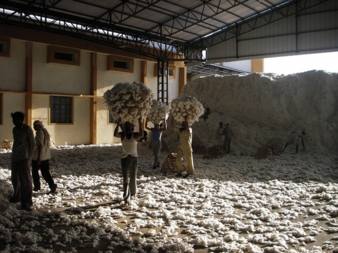07/12/2018 – cotton cultivation — auf Deutsch lesen
Breaking Yield Barriers in Africa
Over the past 30 years, cotton yields in Africa have been stagnant at an average of 350 kg of lint per hectare (ha).
Cotton in Africa is grown mainly in the tropical regions, where abundant sunlight, adequate rainfall and fertile soils (in many countries) should have resulted in high yields and good crop growth.
To achieve a breakthrough in yields and to increase input use efficiency of water and nutrients, Dr. Keshav Kranthi, Head of the Technical Information Section of the ICAC, advises Africa to seriously consider the development and evaluation of the following systems:
• A new system of plant architecture;
• New planting geometry;
• Canopy management;
• Soil health management; and
• Ecological engineering for pest management.
Plant architecture
A critical analysis shows that it is paradoxical that the unabated crop growth could be the main factor that is responsible for low yields. In developed countries such as USA, Australia and Brazil, plant breeders aim to develop cultivars that retain an optimum number of bolls, generally at 15 to 20 bolls per plant, with a population of 80,000 to 110,000 plants per hectare. However, in Africa and Asia, plant breeders traditionally have been developing plant types that produced the highest number of bolls (80 to 150) per plant.
Producing more bolls per plant takes a longer time for higher yields, and if terminated prematurely, result in low yields. Cotton plants need about 80 percent water and nutrients during the flowering and boll-formation stage, which is referred as ‘the critical window’.
The critical window is about 40 to 50 days in a short-duration, high-density crop, whereas it ranges from 80 to 120 days in a long-duration crop like those in Africa or India. Cultivars with high initial shoot and root vigour have competitive advantage over weeds and will also be able to produce adequate number of sympodial branches in a short time to synchronise the critical fruiting window with available soil moisture.
Planting Geometry and Canopy Management
Agronomists should seriously consider standardising optimum plant spacing and try a geometry of 8 to 10 cm between plants in a row, with row-to-row spacing at 30 cm, 45 cm, 60 cm, 75 cm or 90 cm, depending on plant architecture, soil type and environment.
Canopy management is done by restricting plant height to 70 to 80. This is known to reduce boll shedding, increase boll size, increase the number of fruiting nodes, enhance the dry mass of fruiting parts, and increase seed-cotton yields. This practice is followed in 50% to 70% of the farms in China.
Soil Health Management
Improvement of soil health is crucial for good yields. Agronomists must conduct experiments to identify the best conservation tillage options for local conditions. Minimum tillage or zero tillage, crop residue management, and choice of appropriate cover crops and crop rotation would play a crucial role in conservation agriculture. A significant portion of the chemical fertilisers applied in Africa and elsewhere in the world are lost due to improper application. Precision usage is crucial in resource-poor countries like those in Africa.
Ecological Engineering for Pest Management
Integrated pest management (IPM) depends largely on cultivars that are resistant to sap-sucking pests. Seed treatment protects seedlings from pests and diseases. Avoidance of chemical insecticides to control sap-sucking insects prevents disruption in the stabilisation of naturally occurring biological control in the cotton ecosystems. Bollworm management becomes easier with biopesticides, if naturally occurring biological control is conserved by avoidance of chemical insecticides early in the season.
These suggestions are based on success stories and standard practices being followed in developed countries. However, lessons can always be learned from anywhere and adapted to local conditions through rigorous experimentation and validation.
Source: The ICAC Recorder, Vol 3, 2018
Source: Bremen Cotton Report No. 47/48 – December, 6 2018
For more information www.baumwollboerse.de/en/




